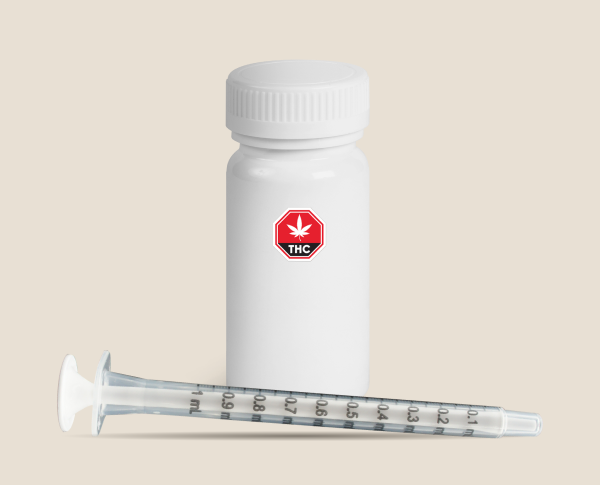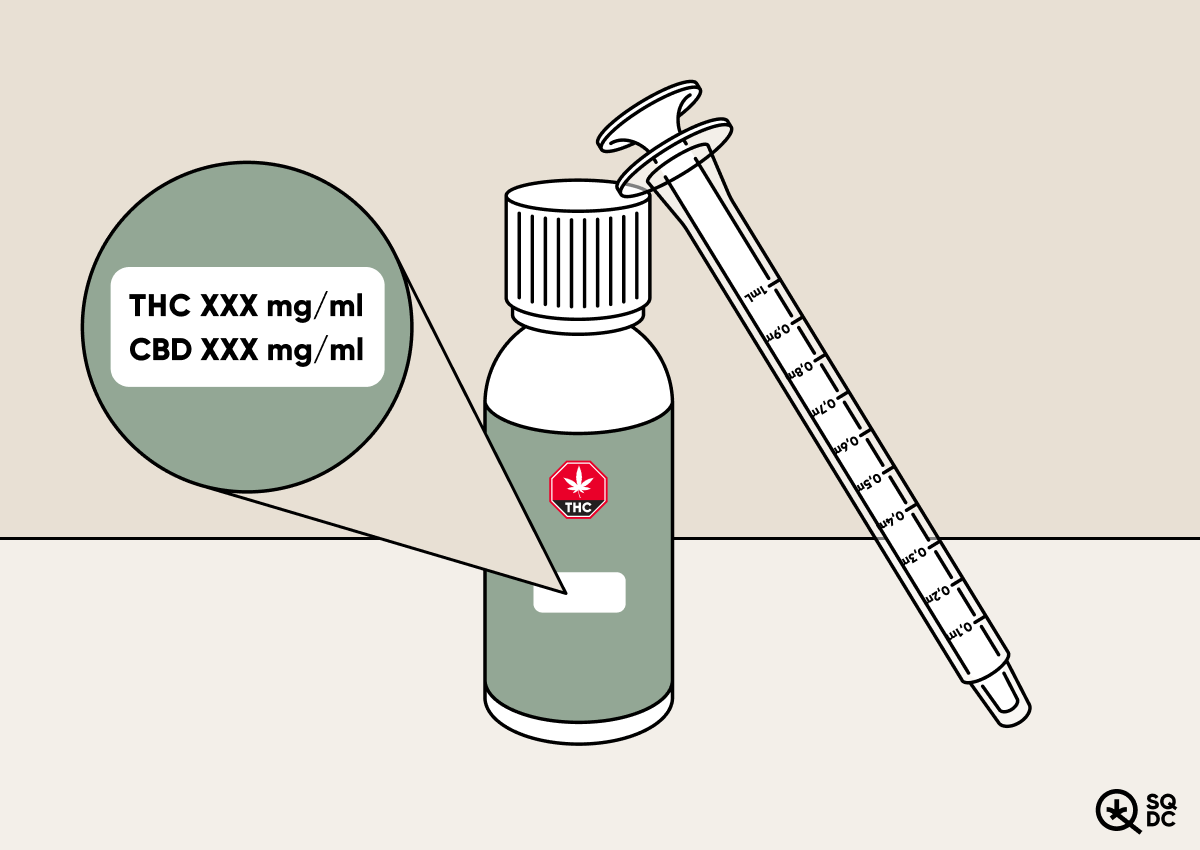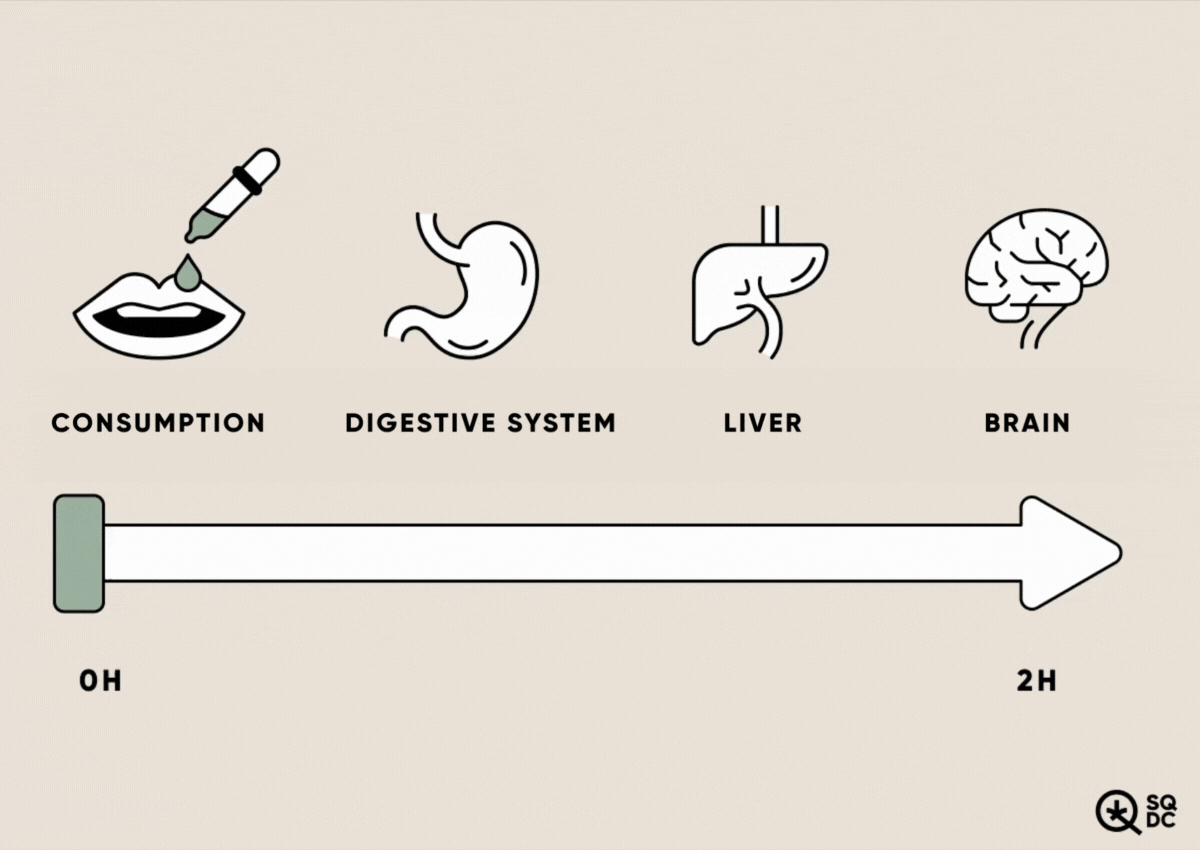Cannabis oil dosage
By SQDC.ca | Published on October 14, 2025
Cannabis oil provides a non-inhalation method of cannabis consumption. Available as oral oils, sprays, or capsules, these products are often preferred by those seeking effects that last longer compared to inhalation.

Though cannabis oils might seem straightforward to use, proper dosing requires careful attention. Unlike inhaled cannabis, which takes effect quickly, ingested oils are processed through the digestive system, resulting in:
- Delayed onset of effects
- Longer lasting and potentially stronger effects
- A greater risk of consuming more than intended
This practical guide will walk you through understanding how cannabis oils work, accurately reading product labels, and safely calculating and adjusting your dosage — especially if you're new to cannabis oils.
Measuring the oil
Cannabis oils are designed to be swallowed and should be administered directly into the mouth using a syringe or sprayed with an atomizer.
Some people prefer to hold the oil under their tongue before swallowing, aiming for quicker effects through partial absorption via mucous membranes. However, this approach is neither mandatory nor guaranteed, as most cannabis oils are formulated for primary absorption through the digestive system.
Key label elements to check
To better understand how THC and CBD amounts are shown on cannabis product labels, visit the SQDC’s official page on the new content units.
When reviewing your product label, look for:
| Label item | Why it matters |
|---|---|
| THC/CBD per activation | Tells you how much milligrams of THC/CBD are present in one activation, which is a specific volume set by the supplier. |
| Volume per activation | Shows the volume (in ml) released per activation to deliver the specified dose. |
Understanding your label gives you better control over the amount you consume and helps reduce the risk of unwanted effects. Up next, we’ll look at how to determine your starting dose.
Calculating the correct dose
Cannabis oil packaging typically indicates:
- Total THC per activation
- Total CBD per activation
These figures tell you how many milligrams of THC or CBD you consume per activation — defined as a standard dose set by the manufacturer.
Note: The volume per activation may vary by manufacturer, meaning an "activation" isn't always the same amount. For example, an activation might be 0.1 ml for some oils and 0.3 ml for others. For atomizers, it's commonly 0.1 ml, equivalent to one spray.
To calculate your dose:
- Find the amount of THC or CBD per activation (e.g., 10 mg of CBD per activation).
- Check the volume corresponding to one activation (e.g., 1 activation = 0.5 ml). So, 0.5 ml gives 10 mg of CBD.
- Adjust based on your desired dose (e.g., for 5 mg of CBD, use 0.25 ml).
Unlike oils, capsules require no calculation, as the dosage per unit is pre-defined. Simply take one capsule for the exact dosage indicated on the package.
For more details, consult our complete article on reading labels and converting mg/g, mg/ml, etc.

Starting dose
The effects of cannabis oils can vary greatly among individuals due to several factors. It's important to start cautiously, especially if you're new to cannabis ingestion.
Recommended starting doses
Health Canada and SQDC suggest the following conservative starting points:
| Cannabinoid | Starting Dose |
|---|---|
| THC | 2.5 mg |
| CBD | 5 mg |
These doses are meant to minimize unwanted effects and allow you to observe how your body reacts.
Some oils may contain more than this initial dose per activation, highlighting the importance of carefully reading product labels and gradually adjusting your intake.
Waiting for the effects
Cannabinoids must pass through the stomach and be metabolized by the liver before taking effect, a process typically taking between 30 minutes and 2 hours.
The delay in onset may lead to taking another dose before feeling the first one. However, once the effects begin, they can be intense and difficult to manage if the dose is too high. Effects can last up to 8 hours or more. It's safer to wait patiently and increase your dose gradually to avoid uncomfortable effects like confusion or anxiety.

Adjusting your dose safely: how to find your sweet spot
Once you've tried your starting dose and observed how your body reacts, you can begin to adjust your dosage gradually to find the amount that provides the desired effect without causing discomfort.
This process is often referred to as “titration.” It simply means slowly increasing or decreasing your dose until you hit your “sweet spot” — the minimum effective dose that works for your body.
Step-by-step guide to titrating your dose
- Start low: Begin with 2.5 mg THC or 5 mg CBD — or less if you're very sensitive.
-
Wait patiently: Give your body time to metabolize the cannabinoids.
- Minimum wait: 2 hours
- Ideal wait: 6–8 hours or until the next day
- Observe effects: Take note of how you feel. Any side effects?
- Adjust in small increments: Increase your dose by no more than 1–2.5 mg THC or 5 mg CBD at a time.
- Keep a log: Write down the product, amount taken, timing, and how you felt. This helps you track patterns and avoid going too far.
Why you might not feel the effects
It's not uncommon for first-time users of cannabis oil to wonder: "Why am I not feeling anything?".
There are several legitimate reasons why the effects might be subtle — or even absent — during your initial experiences. The good news? With time, observation, and small adjustments, most people find the right approach for their body.
1. You didn’t wait long enough
Unlike smoking or vaping, cannabis oil must be:
- Digested in the stomach
- Processed by the liver
- Absorbed into the bloodstream
This process can take 30 minutes to 2 hours, sometimes even longer depending on:
- Whether you ate recently
- Your metabolism
- The formulation of the oil
Tempted to redose early? That’s a common mistake. Always wait the full 2 hours before considering more — and ideally, track your response over a few days to spot consistent patterns.
2. Your dose might be too low
The recommended starting dose is intentionally small — not necessarily to feel strong effects, but to test your tolerance safely.
If you don’t feel anything:
- Consider staying at the same dose for a few more sessions
- Then slowly increase by 1–2 mg THC or 5 mg CBD at a time
- Give your body time to adjust before deciding it “doesn’t work”
3. Your body absorbs cannabinoids differently
Just like with medications or supplements, some people are fast metabolizers, while others absorb cannabinoids more slowly or less effectively.
Possible reasons for reduced absorption include:
- Individual gut enzyme activity
- Differences in liver metabolism
- Natural variation in the endocannabinoid system
In some cases, cannabinoids can be partially broken down before they reach your bloodstream, especially with digestion-based products.
What to consider if you don’t feel the effects you were looking for
- Be patient: Your body may need time to adjust or find the right delivery method
- Track your reactions: Time of day, food intake, dosage
- Titrate slowly: If you need to adjust your dose, increase by only 1–2 mg at a time and wait to observe the effects before making any further changes.
- Speak to a SQDC advisor, in stores or in online chat, if you’re unsure about product choice or expected effects
Frequently asked questions
Products
-
Do oral sprays take effect faster than other cannabis oil products?
No. Oral sprays, like other oils, are primarily absorbed through the digestive system rather than mucous membranes. Specialized nano-emulsion products or oral strips are specifically designed for mucosal absorption.
-
Why don't I feel any effects when consuming cannabis oils?
Several reasons could explain this:
- The dose might be too low for you: Start low and observe your reactions over multiple sessions before increasing your dosage.
- Your body absorbs cannabinoids differently: Individual metabolism and absorption vary, and cannabinoids might be partially degraded before reaching your bloodstream, reducing the effects.
-
Which cannabis oil product suits my needs best?
Oils, oral sprays, and capsules all contain cannabis oil but differ in ease of dosage and administration. Graduated syringes offer flexible dosing, while capsules provide fixed doses, which might be less suitable for first-time users who want to explore their ideal dose through trial and error.
-
Can I take the same amount of cannabinoids as when smoking cannabis?
No. Ingested and inhaled cannabis differ significantly. Ingestion involves metabolism by the liver, making the effects longer-lasting and potentially stronger. Additionally, inhalation leads to cannabinoid loss during combustion. Begin with 2.5 mg THC or 5 mg CBD and adjust slowly, if desired, based on your experience.







